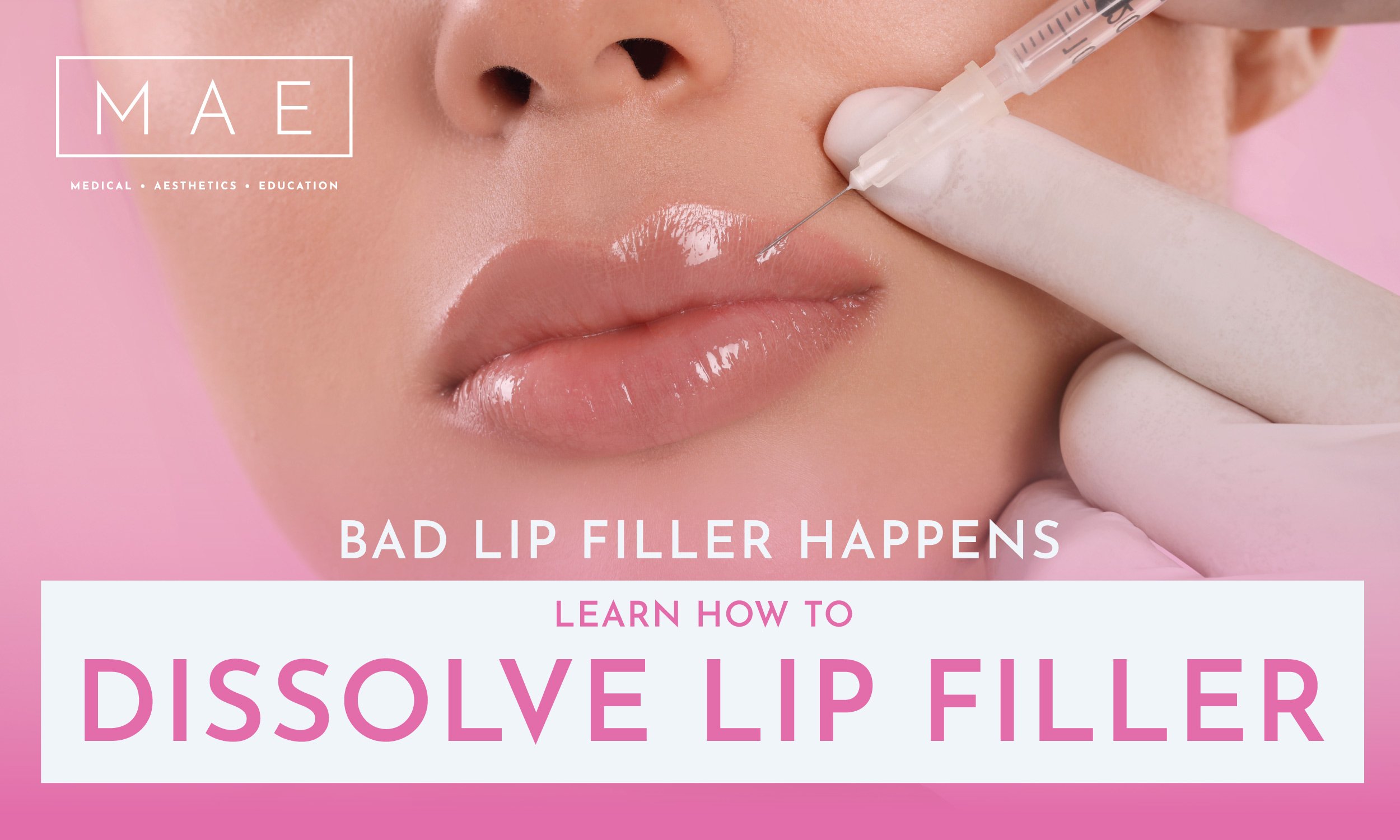Understanding Hyaluronidase | How to Dissolve Lip Filler
While lip fillers are a trend that doesn’t seem to be going anywhere any time soon, one procedure that is increasing in demand as a result of lip injection popularity is lip filler reversal. Whether patients aren’t satisfied with their results, are allergic to the filler, or their repeated lip filler treatments have taken a negative toll, you must be ready to dissolve lip fillers as a professional injector!
At Medical Aesthetics Education (MAE) in Bellaire, TX, we understand the importance of equipping future professionals in the aesthetic treatment field with accurate and detailed information. That’s why we want to dive into the process of dissolving lip fillers, discussing the role of hyaluronidase, the benefits and risks involved, and the procedure itself.
We want you to have a thorough understanding of dissolving lip fillers and be prepared to confidently and safely incorporate this technique into your aesthetic practice.
Welcome to our comprehensive guide on how to dissolve lip fillers using hyaluronidase!
Understanding Hyaluronidase
Hyaluronidase is an enzyme that plays a crucial role in the breakdown of hyaluronic acid (HA). HA is a primary component of many dermal fillers, including those used for lip augmentation. As an aesthetic injector, it is essential for you to understand how hyaluronidase interacts with hyaluronic acid and the impact it has on filler dissolution.
Benefits of Dissolving Lip Fillers with Hyaluronidase
Corrective Measures and Artistic Flexibility
One of the significant advantages of using hyaluronidase to dissolve lip fillers is its ability to modify or reverse the results of previous treatments. This allows for your artistic flexibility, empowering you to fine-tune and adjust the size, shape, or symmetry of your clients' lips. By mastering the technique of lip filler dissolution, you can provide corrective measures and fulfill the unique aesthetic goals of your patients.
Enhanced Safety and Natural-Looking Results
Dissolving lip fillers with hyaluronidase offers a safer alternative to surgical removal or other invasive methods. By specifically targeting hyaluronic acid, a naturally occurring substance in our bodies, the procedure ensures a more natural-looking outcome. As an aesthetic injector, this aspect of the technique enhances patient satisfaction and contributes to the overall success of your practice.
Efficiency and Immediate Results
The procedure of dissolving lip fillers using hyaluronidase is known for its efficiency and prompt results. As an aesthetic injector in training, incorporating this technique into your repertoire allows you to offer timely corrections and adjustments to your patients' lip augmentations. This quick turnaround time can enhance client satisfaction and lead to positive word-of-mouth referrals.
How to Dissolve Lip Fillers: A Step-By-Step Guide
Step 1: Patient Consultation and Assessment
Before initiating the dissolving procedure, it’s crucial to conduct a thorough consultation with your patient. During this stage, you will assess their specific case, including the type of filler used, the amount injected, and their desired outcome. These evaluations will guide you in determining the appropriate dosage of hyaluronidase required for the dissolution process.
Step 2: Precise Application of Hyaluronidase
Once the assessment is complete, you will proceed with the application of hyaluronidase. This step involves injecting the enzyme directly into the treated area using a fine needle. As an aesthetic injector, it’s crucial to develop proficiency in accurate placement and dosage to maximize the effectiveness of the dissolving process.
Step 3: Monitoring and Follow-Up
Following the dissolving treatment, closely monitor the patient's progress and provide comprehensive aftercare instructions. Proper monitoring and guidance during the healing process will minimize potential side effects and optimize results. Be sure to establish clear communication channels with your patients and schedule follow-up appointments to track their progress effectively.
Risks and Considerations
While dissolving lip fillers using hyaluronidase is generally safe, it is crucial to be aware of potential risks and considerations associated with the procedure. Here are some that you should be aware of so your patients are in good hands.
Allergic Reactions
Although rare, some individuals may experience allergic reactions to hyaluronidase. As an aesthetic injector, it is vital to remain vigilant and inquire about any history of allergies or adverse reactions before proceeding with the treatment. Being prepared to handle allergic reactions promptly is essential for ensuring patient safety.
Temporary Side Effects
After the procedure, patients may experience temporary side effects such as swelling, redness, or discomfort at the injection site. Educating your patients about these potential effects and providing appropriate post-treatment care instructions will help manage their expectations and ensure a positive experience.
Multiple Sessions
In some cases, complete removal of lip fillers may require multiple sessions. This depends on factors such as the amount and type of filler being dissolved. Maintaining open communication with your patients and adjusting the treatment plan accordingly will optimize results and patient satisfaction.
Be the Best Injector You Can Be with Hands-On Training at MAE!
As an aesthetic injector, understanding the technique for dissolving lip fillers using hyaluronidase is a valuable addition to your skill set. The ability to offer corrective measures, ensure patient safety, and achieve natural-looking results contributes to your overall success in the field as well.
Remember the importance of regular education and staying up-to-date with advancements in the field as you continue on your journey as an injector. These elements will enable you to provide the highest quality of care to your patients.
MAE offers injection training courses and an unmatched Mentorship Program to help you become the best injector possible for your patients’ satisfaction and your business’s success.
Contact us today with questions about our injection training offerings!


